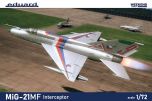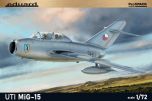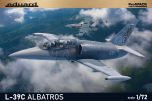Eduard 1/72 Aces Of The Eighth Dual Combo Limited Edition # 2147
Limited edition kit of WWII US fighter aircraft P-51D in 1/72 scale. All markings are of the units of the 8th Air Force.
The plastic kit includes parts for two scale models.
- Plastic parts: Eduard
- Marking options: 12
- Decals: Eduard
- PE parts: yes, pre-painted
- Painting mask:yes
- Resin parts: no
COL A P-51D-5, s/n 44-13321, Maj. George Preddy Jr., 487th FS, 352nd FG, Bodney, United Kingdom, July 1944
COL B P-51D-10, 44-14221, Maj. Pierce W. McKennon, CO of 335th FS, 4th FG, Debden, United Kingdom, April 1945
COL C P-51D-10, 44-14733, Capt. Ray S. Wetmore, 370th FS, 359th FG, East Wretham, United Kingdom, March 1944
COL D P-51D-20, 44-72218, Lt Col. John D. Landers, CO of 78th FG, Duxford, United Kingdom, March 1945
COL E P-51D-5, 44-13316, Maj. Leonard K. Carson, 362nd FS, 357th FG, USAAF Station 373 Leiston, Suffolk, Great Britain, June 1944
COL F P-51D-15, 44-15152, Maj. Donald J. Strait, 361st FS, 365th FG, United Kingdom, February 1945
COL G P-51D-10, 44-14223, Lt. Col. Elwyn G. Righetti, CO of 55th FG, 8th AF, Wormingford, United Kingdom, January 1945
COL H P-51D-10, 44-14164, Lt. Urban L. Drew, 375th FS, 361st FG, Little Walden, October 1944
COL I P-51D-5, 44-13761, Capt. Jack M. Ilfrey, 79th FS, 20th FG, 8th AF, USAAF Station 367 Kings Cliffe, Northamptonshire, Great Britain, autumn 1944
COL J P-51D-10, 44-14372, Capt. Kirk B. Everson, 504th FS, 339th FG, 8th AF, Fowlmere, United Kingdom, April 1945
COL K P-51D-5, s/n 44-13677, flown Lt. William G. Cullerton, 357th FS, 355th FG, Steeple Morden, United Kingdom, 1944
COL L P-51D-25, 44-73060, Col. Glenn E. Duncan, 350th FS, 353rd FG, Raydon, United Kingdom, April 1945
 Spread the cost with Paypal Credit
0% for 24 months available on orders over £199
Spread the cost with Paypal Credit
0% for 24 months available on orders over £199
 Spread the cost with Klarna
0% for 24 months available on orders over £199
Spread the cost with Klarna
0% for 24 months available on orders over £199
![]()
The North American P-51D Mustang, operated by the 8th Air Force, stands as one of the most iconic fighter aircraft of World War II.
enowned for its exceptional performance, range, and versatility, the P-51D played a pivotal role in securing Allied air superiority over Europe.
Engine and Performance:
Engine: The P-51D was powered by the Packard V-1650-7, a license-built version of the Rolls-Royce Merlin engine. This engine provided 1,490 horsepower, significantly enhancing the aircraft's performance at high altitudes.
Speed: The P-51D could reach speeds of up to 437 mph (703 km/h) at 25,000 feet (7,620 meters).
Range: Equipped with drop tanks, the P-51D had an impressive operational range of approximately 1,650 miles (2,655 kilometers), allowing it to escort bombers deep into enemy territory and return safely.
Armament:
Machine Guns: The aircraft was armed with six .50 caliber M2 Browning machine guns, three in each wing, providing substantial firepower for engaging enemy aircraft and ground targets.
Ordnance: The P-51D could carry up to 2,000 pounds of bombs or rockets, enhancing its capability for ground-attack missions.
Design and Aerodynamics:
Airframe: The P-51D featured a sleek, aerodynamic design with a laminar flow wing, reducing drag and improving speed and maneuverability.
Canopy: A notable improvement in the P-51D was the introduction of the bubble canopy, replacing the earlier "birdcage" design. This provided the pilot with unparalleled visibility, crucial for situational awareness during combat.
Tail: The P-51D had a taller tailfin and rudder, improving stability and control, especially at high speeds.
Operational Use:
Roles: The P-51D served primarily as a long-range escort fighter, protecting Allied bombers on their missions over Nazi-occupied Europe. It also performed ground-attack and reconnaissance missions effectively.
Combat: Pilots of the 8th Air Force flying the P-51D were instrumental in achieving air superiority, engaging and defeating Luftwaffe fighters, thereby reducing the threat to Allied bombers. The Mustang's range and performance allowed it to accompany bombers all the way to their targets and back.
Deployment: The 8th Air Force, based in England, was the primary American strategic air force in Europe, and the P-51D became a symbol of its offensive power.
Legacy:
Impact: The P-51D Mustang was crucial in shifting the balance of air power in favor of the Allies. Its ability to escort bombers deep into enemy territory significantly reduced bomber losses and increased the effectiveness of the Allied bombing campaign.
Aces: Many American aces flew the P-51D with the 8th Air Force, achieving numerous aerial victories and contributing to the aircraft's legendary status.
The North American P-51D Mustang of the 8th Air Force was a game-changing fighter aircraft during World War II.
Its combination of speed, range, and firepower allowed it to excel in various combat roles, most notably as a long-range bomber escort.
The P-51D’s contributions to the Allied victory in Europe solidify its legacy as one of the most effective and celebrated fighter aircraft in the history of military aviation.
| SKU | EDK2147 |
|---|---|
| Manufacturer | Eduard |
| Scale | 1/72 |
| EAN | 8591437590650 |
| Short Description | Limited edition kit of WWII US fighter aircraft P-51D in 1/72 scale. All markings are of the units of the 8th Air Force. The plastic kit includes parts for two scale models. - Plastic parts: Eduard COL A P-51D-5, s/n 44-13321, Maj. George Preddy Jr., 487th FS, 352nd FG, Bodney, United Kingdom, July 1944 |
-
 Eduard 1/72 Messerschmitt Bf-109F-4 ProfiPACK Edition # 70155Special Price £12.96 was £14.40 Save 10%
Eduard 1/72 Messerschmitt Bf-109F-4 ProfiPACK Edition # 70155Special Price £12.96 was £14.40 Save 10% -
 Eduard 1/72 Focke-Wulf Fw-190A-5 # 7470Special Price £10.79 was £11.99 Save 10%
Eduard 1/72 Focke-Wulf Fw-190A-5 # 7470Special Price £10.79 was £11.99 Save 10% -
 Eduard 1/72 Mikoyan MiG-21MF Interceptor Weekend Edition # 7469Special Price £11.97 was £13.30 Save 10%
Eduard 1/72 Mikoyan MiG-21MF Interceptor Weekend Edition # 7469Special Price £11.97 was £13.30 Save 10% -
 Eduard 1/72 Mikoyan MiG-15UTI ProfiPACK Edition # 7055Special Price £14.67 was £16.30 Save 10%
Eduard 1/72 Mikoyan MiG-15UTI ProfiPACK Edition # 7055Special Price £14.67 was £16.30 Save 10% -
 Eduard 1/72 Messerschmitt Bf-110G-2 Weekend Edition # 7468Special Price £24.93 was £27.70 Save 10%
Eduard 1/72 Messerschmitt Bf-110G-2 Weekend Edition # 7468Special Price £24.93 was £27.70 Save 10% -
 Eduard 1/72 North-American B-25J Mitchell STRAFER ProfiPACK Edition # 7012Special Price £36.89 was £40.99 Save 10%
Eduard 1/72 North-American B-25J Mitchell STRAFER ProfiPACK Edition # 7012Special Price £36.89 was £40.99 Save 10% -
 Eduard 1/72 B-26F/G Marauder Limited Edition # 2146Special Price £31.49 was £34.99 Save 10%
Eduard 1/72 B-26F/G Marauder Limited Edition # 2146Special Price £31.49 was £34.99 Save 10% -
 Eduard 1/72 Messerschmitt Bf-109G-6 ProfiPACK Edition # 70159Special Price £12.59 was £13.99 Save 10%
Eduard 1/72 Messerschmitt Bf-109G-6 ProfiPACK Edition # 70159Special Price £12.59 was £13.99 Save 10% -
 Eduard 1/72 Gustav Pt.2 Dual Combo Limited Edition # 2145Special Price £22.95 was £25.50 Save 10%
Eduard 1/72 Gustav Pt.2 Dual Combo Limited Edition # 2145Special Price £22.95 was £25.50 Save 10% -
 Eduard 1/72 Supermarine Spitfire Mk.IXc Late Weekend Edition # 7473Special Price £10.79 was £11.99 Save 10%
Eduard 1/72 Supermarine Spitfire Mk.IXc Late Weekend Edition # 7473Special Price £10.79 was £11.99 Save 10% -
 Eduard 1/72 Messerschmitt Bf-109G-2 ProfiPACK Edition # 70156Special Price £12.59 was £13.99 Save 10%
Eduard 1/72 Messerschmitt Bf-109G-2 ProfiPACK Edition # 70156Special Price £12.59 was £13.99 Save 10% -
 Eduard 1/72 Aero L-39C Albatros ProfiPACK Edition # 7044Special Price £11.69 was £12.99 Save 10%
Eduard 1/72 Aero L-39C Albatros ProfiPACK Edition # 7044Special Price £11.69 was £12.99 Save 10% -
 Eduard 1/72 Bf-109G Gustav Pt.1 Dual Combo Limited Edition # 2144Special Price £22.95 was £25.50 Save 10%
Eduard 1/72 Bf-109G Gustav Pt.1 Dual Combo Limited Edition # 2144Special Price £22.95 was £25.50 Save 10% -
 Eduard 1/72 Avia S-199 ERLA Canopy Weekend Edition # 7472Special Price £10.79 was £11.99 Save 10%
Eduard 1/72 Avia S-199 ERLA Canopy Weekend Edition # 7472Special Price £10.79 was £11.99 Save 10% -
 Eduard 1/72 Focke-Wulf Fw-190A-8/R2 Weekend Edition # 7467Special Price £10.79 was £11.99 Save 10%
Eduard 1/72 Focke-Wulf Fw-190A-8/R2 Weekend Edition # 7467Special Price £10.79 was £11.99 Save 10% -
 Eduard 1/72 Messerschmitt Bf-109F-2 ProfiPACK Edition # 70154Special Price £12.96 was £14.40 Save 10%
Eduard 1/72 Messerschmitt Bf-109F-2 ProfiPACK Edition # 70154Special Price £12.96 was £14.40 Save 10% -
 Eduard 1/72 Messerschmitt Bf-109F-4 ProfiPACK Edition # 70155Special Price £12.96 was £14.40 Save 10%
Eduard 1/72 Messerschmitt Bf-109F-4 ProfiPACK Edition # 70155Special Price £12.96 was £14.40 Save 10% -
 Eduard 1/72 Focke-Wulf Fw-190A-5 # 7470Special Price £10.79 was £11.99 Save 10%
Eduard 1/72 Focke-Wulf Fw-190A-5 # 7470Special Price £10.79 was £11.99 Save 10% -
 Eduard 1/72 Mikoyan MiG-21MF Interceptor Weekend Edition # 7469Special Price £11.97 was £13.30 Save 10%
Eduard 1/72 Mikoyan MiG-21MF Interceptor Weekend Edition # 7469Special Price £11.97 was £13.30 Save 10% -
 Eduard 1/72 Mikoyan MiG-15UTI ProfiPACK Edition # 7055Special Price £14.67 was £16.30 Save 10%
Eduard 1/72 Mikoyan MiG-15UTI ProfiPACK Edition # 7055Special Price £14.67 was £16.30 Save 10% -
 Eduard 1/72 Messerschmitt Bf-110G-2 Weekend Edition # 7468Special Price £24.93 was £27.70 Save 10%
Eduard 1/72 Messerschmitt Bf-110G-2 Weekend Edition # 7468Special Price £24.93 was £27.70 Save 10% -
 Eduard 1/72 North-American B-25J Mitchell STRAFER ProfiPACK Edition # 7012Special Price £36.89 was £40.99 Save 10%
Eduard 1/72 North-American B-25J Mitchell STRAFER ProfiPACK Edition # 7012Special Price £36.89 was £40.99 Save 10% -
 Eduard 1/72 B-26F/G Marauder Limited Edition # 2146Special Price £31.49 was £34.99 Save 10%
Eduard 1/72 B-26F/G Marauder Limited Edition # 2146Special Price £31.49 was £34.99 Save 10% -
 Eduard 1/72 Messerschmitt Bf-109G-6 ProfiPACK Edition # 70159Special Price £12.59 was £13.99 Save 10%
Eduard 1/72 Messerschmitt Bf-109G-6 ProfiPACK Edition # 70159Special Price £12.59 was £13.99 Save 10% -
 Eduard 1/72 Gustav Pt.2 Dual Combo Limited Edition # 2145Special Price £22.95 was £25.50 Save 10%
Eduard 1/72 Gustav Pt.2 Dual Combo Limited Edition # 2145Special Price £22.95 was £25.50 Save 10% -
 Eduard 1/72 Supermarine Spitfire Mk.IXc Late Weekend Edition # 7473Special Price £10.79 was £11.99 Save 10%
Eduard 1/72 Supermarine Spitfire Mk.IXc Late Weekend Edition # 7473Special Price £10.79 was £11.99 Save 10% -
 Eduard 1/72 Messerschmitt Bf-109G-2 ProfiPACK Edition # 70156Special Price £12.59 was £13.99 Save 10%
Eduard 1/72 Messerschmitt Bf-109G-2 ProfiPACK Edition # 70156Special Price £12.59 was £13.99 Save 10% -
 Eduard 1/72 Aero L-39C Albatros ProfiPACK Edition # 7044Special Price £11.69 was £12.99 Save 10%
Eduard 1/72 Aero L-39C Albatros ProfiPACK Edition # 7044Special Price £11.69 was £12.99 Save 10% -
 Eduard 1/72 Bf-109G Gustav Pt.1 Dual Combo Limited Edition # 2144Special Price £22.95 was £25.50 Save 10%
Eduard 1/72 Bf-109G Gustav Pt.1 Dual Combo Limited Edition # 2144Special Price £22.95 was £25.50 Save 10% -
 Eduard 1/72 Avia S-199 ERLA Canopy Weekend Edition # 7472Special Price £10.79 was £11.99 Save 10%
Eduard 1/72 Avia S-199 ERLA Canopy Weekend Edition # 7472Special Price £10.79 was £11.99 Save 10% -
 Eduard 1/72 Focke-Wulf Fw-190A-8/R2 Weekend Edition # 7467Special Price £10.79 was £11.99 Save 10%
Eduard 1/72 Focke-Wulf Fw-190A-8/R2 Weekend Edition # 7467Special Price £10.79 was £11.99 Save 10% -
 Eduard 1/72 Messerschmitt Bf-109F-2 ProfiPACK Edition # 70154Special Price £12.96 was £14.40 Save 10%
Eduard 1/72 Messerschmitt Bf-109F-2 ProfiPACK Edition # 70154Special Price £12.96 was £14.40 Save 10% -
 Eduard 1/72 Messerschmitt Bf-109F-4 ProfiPACK Edition # 70155Special Price £12.96 was £14.40 Save 10%
Eduard 1/72 Messerschmitt Bf-109F-4 ProfiPACK Edition # 70155Special Price £12.96 was £14.40 Save 10% -
 Eduard 1/72 Focke-Wulf Fw-190A-5 # 7470Special Price £10.79 was £11.99 Save 10%
Eduard 1/72 Focke-Wulf Fw-190A-5 # 7470Special Price £10.79 was £11.99 Save 10% -
 Eduard 1/72 Mikoyan MiG-21MF Interceptor Weekend Edition # 7469Special Price £11.97 was £13.30 Save 10%
Eduard 1/72 Mikoyan MiG-21MF Interceptor Weekend Edition # 7469Special Price £11.97 was £13.30 Save 10% -
 Eduard 1/72 Mikoyan MiG-15UTI ProfiPACK Edition # 7055Special Price £14.67 was £16.30 Save 10%
Eduard 1/72 Mikoyan MiG-15UTI ProfiPACK Edition # 7055Special Price £14.67 was £16.30 Save 10% -
 Eduard 1/72 Messerschmitt Bf-110G-2 Weekend Edition # 7468Special Price £24.93 was £27.70 Save 10%
Eduard 1/72 Messerschmitt Bf-110G-2 Weekend Edition # 7468Special Price £24.93 was £27.70 Save 10% -
 Eduard 1/72 North-American B-25J Mitchell STRAFER ProfiPACK Edition # 7012Special Price £36.89 was £40.99 Save 10%
Eduard 1/72 North-American B-25J Mitchell STRAFER ProfiPACK Edition # 7012Special Price £36.89 was £40.99 Save 10%


























